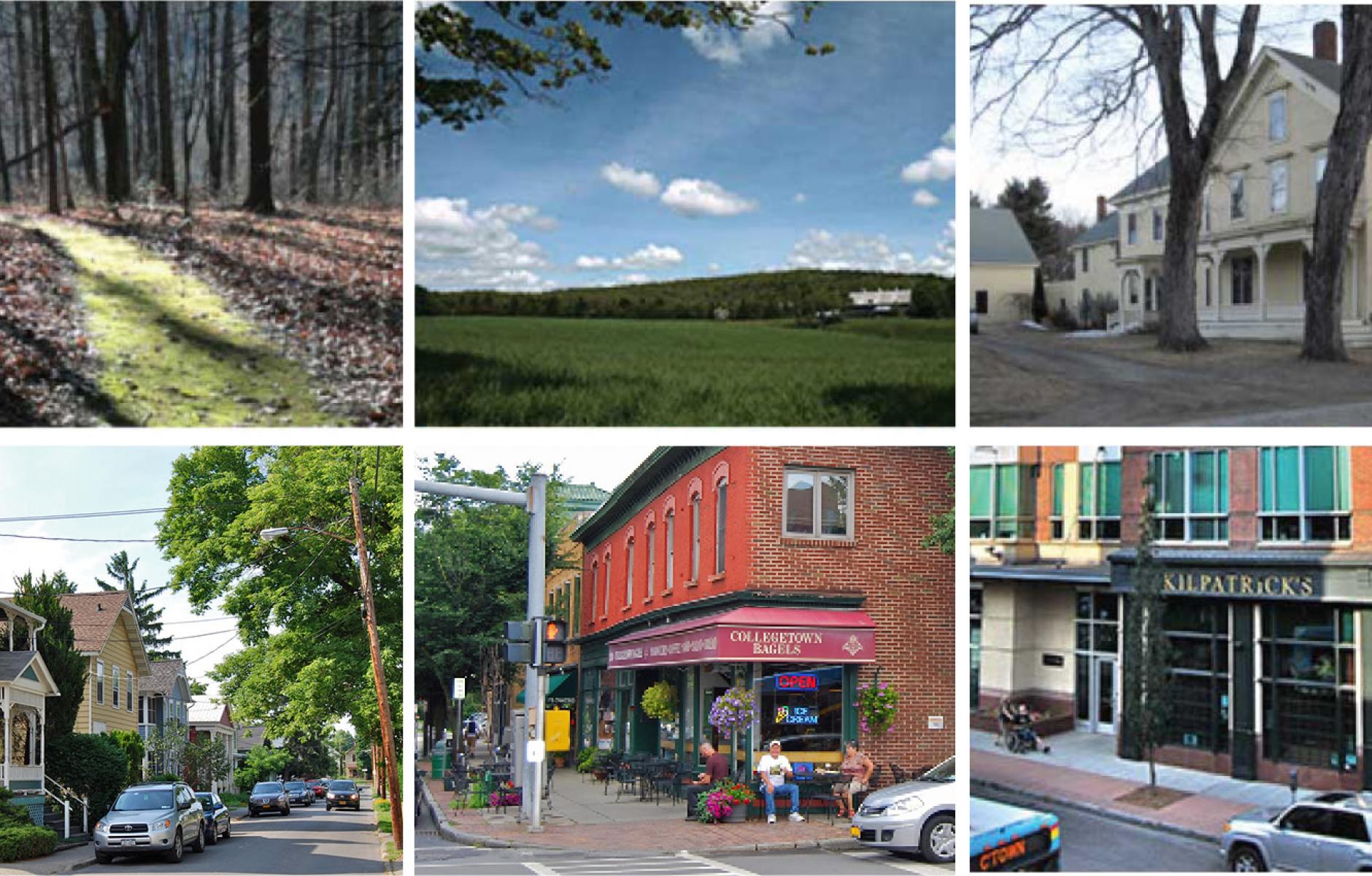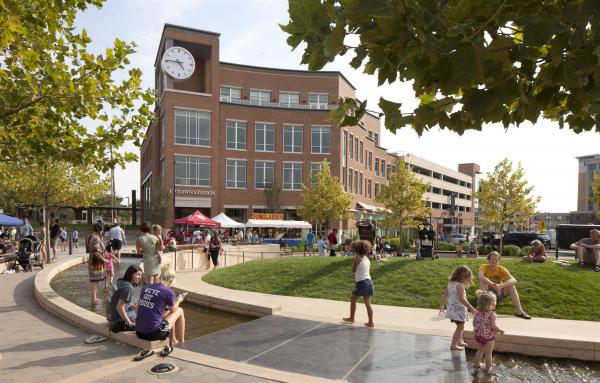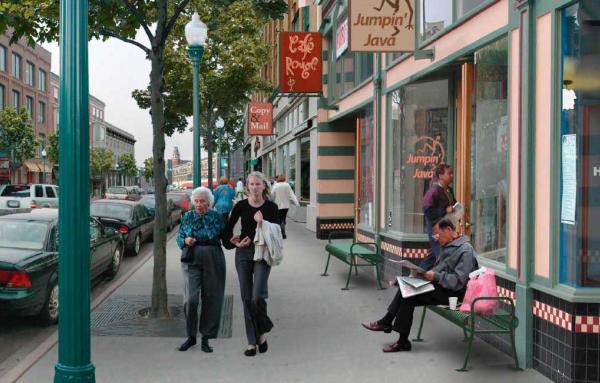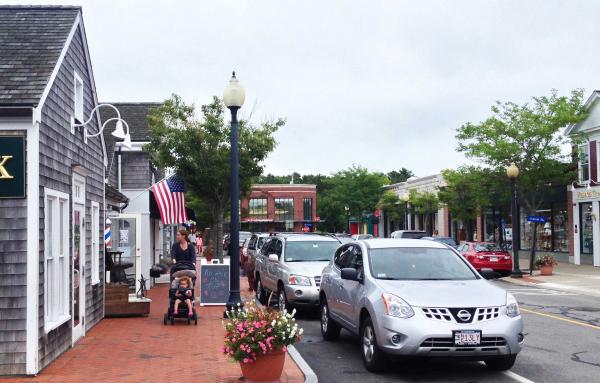
Great idea: The rural-to-urban Transect
In celebration of the upcoming CNU 25.Seattle, Public Square is running the series 25 Great Ideas of the New Urbanism. These ideas have been shaped by new urbanists and continue to influence cities, towns, and suburbs. The series is meant to inspire and challenge those working toward complete communities in the next quarter century.
The rural-to-urban Transect is a system that places all of the elements of the built environment in useful order, from most rural to most urban. For example, a street is more urban than a road, a curb more urban than a swale, a brick wall more urban than a wooden one, and greater density is more urban than less density. If all of the built elements are in sync, the place can be described as "immersive." The elements are symbiotic.
Naturalists use the transect concept to describe the characteristics of ecosystems and the transition from one ecosystem to another. Andres Duany and other urbanists applied this concept to human settlements, and since about 2000 this idea has permeated the thinking of new urbanists. The rural-to-urban Transect is divided into six zones: natural (T1), rural (T2), sub-urban (T3), general urban (T4), center (T5), and core (T6). The remaining category, Special District, applies to parts of the built environmental with specialty uses that do not fit into neighborhoods.
The Transect has been especially useful as a framework to code complete communities. The SmartCode, an open-source, widely used form-based code, is based on the Transect and was first published in 2003.
Public Square editor Robert Steuteville interviewed Andres Duany, principal of DPZ Partners, author of Suburban Nation, and one of the founders of the Congress for the New Urbanism, and Sandy Sorlien, managing editor of DPZ's SmartCode and expert in Transect-based coding, on the rural-to-urban Transect.

How does the Transect fit the built environment into the natural environment and why is this important?
Sorlien: I think it's more of a continuum, a series of different habitats that go from rural to urban or less urban to more urban. In New Urbanism, the community, the neighborhood, the town, the village, and the urban neighborhood are each composed from the three or four more urban Transect zones, and then rural zones T2 and T1 would be more or less outside the community.
Duany: What you said is very intriguing—which is that there is a place for nature and urbanism, and urbanism and nature. The same mechanism, the Transect, is used to assess both the natural and the man-made, which means that nature can be understood by urbanists, and urbanism by environmentalists.
To me, the Transect puts the built environment in a context of the natural environment so it's understood as a continuum and not something that's completely apart.
Duany: Well, let me put it this way. I think it's more blended than that. They both consist of habitats, and both habitats have a series of elements that symbiotically exist in each zone with different intensities. So it's not one or the other. The key is that it's the same methodology used to analyze the whole spectrum of the natural and the built world.
It allows for the best of nature and the best of urbanism, but all the places in between still exist, and so the codes exist in a way to compensate for whatever deficiency there is. Let’s say Manhattan is perfect and Yellowstone is perfect. But there's a lot of stuff in between, and the codes adjudicate all the different mixtures and intensities.
Sorlien: It’s a matter of scale as well. There may be a city that takes up a large area of land without pure nature anywhere nearby, or there may be a small village where pure nature is more or less just outside the village.

Environmentalists may prefer T1 [natural], and the urbanists T6 [urban core], and the codes can mediate what is in between.
Duany: For example, nature in its pure form has a lot of natural diversity. T6 has a lot of cultural diversity or social diversity, and then the stuff in between mixes the diversity of both. But the common currency is diversity.
Sorlien: But we have to be careful not to assign complete diversity to each individual zone. That works for the natural zone, which usually takes up a large area of land, perhaps hundreds of miles, but the urban code is not like that. When you zoom into the fine grain, you find neighborhood general, urban center, and urban core mixed in the large downtown.
Duany: But that's once it's coded. The ingredient is the Transect. Then the code is what the chef does with it to balance it out and make it work better. But you're right in the sense that things are always off-kilter. In fact, the problem with our cities and our nature is that everything tends toward monoculture and so that's why we intervene, to keep it diverse.
Sorlien: That's really interesting. I've never heard that or thought of it that way. Do you think the automobile informs this trend toward monoculture?
Duany: The automobile has permitted the dispersion into monocultures. Before it, everybody needed everything else nearby, particularly employment. Now, take Texas for instance. The rich can live on the beautiful land with oaks, but their gardeners live far away in the lowland with the mosquitoes. On the highways in between, the retail gathers there. The automobile allows for these sorts of aggregations.
But isn't that about policy too? We have coded all across America for these monocultural zones. I don't know that the automobile would have done that on its own.
Duany: Zoning is so easy to do because it supports the tendency toward monoculture—that's why people don't fight it. Zoning is not the cause here, but an effect.
You both described Transect zones as habitat zones. What does that mean?
Duany: Originally, the transect was an environmental methodology to describe changes in habitat over a gradient. The New Urbanism brought this methodology into the city, into urbanism, and made it all compatible with the environmental transect.
Sorlien: It's important to note that a transect, small T, not the New Urbanist's rural-to-urban Transect, is simply a cut or a path through the environment of any length. It could be a whole continent. It could be just a few feet. So it allows for sampling to analyze the components of that particular part of a habitat. We do the same thing with the synoptic survey method that samples the best parts of a community in order to analyze its DNA and code for more of it. In that way, it is similar to how biologists would use a transect.
But people are not used to hearing about habitat zones for humans. They may think of it in terms of a lizard or a giraffe but they don't necessarily think of humans as inhabiting a zone. Could you elaborate on that a little bit?
Duany: I would disagree. The word ‘habitat’ has been used for a long time to describe human settlement, since the 1950s, most prominently by the United Nations Habitat program.
Sorlien: There’s similarity between nature and urbanism if both are considered habitats, particularly with regards to overlap. A diagram that draws a natural habitat as transect, maybe it includes ocean, the beach, the first set of dunes, etc. All of these overlap and are continuous. There's no hard line. I think sometimes that the DPZ diagram of the Transect (see above) makes people think that the habitats differ radically from each other in a mechanized and unnatural way. But in fact, in best practices, we code overlaps.
Duany: Every other Transect zone, T2, T4, and T6, are actually transition zones. They're what in environmentalism is called an ecotone, the overlap of two ecozones. For example, T4 is a combination of T3 and T5. And T2 is a piece of nature that's actually been slightly urbanized. It's also in transition. So the six zones of the Transect include both ecotones and ecozones in exact parallel to how nature actually overlaps. As an aside, in nature-- the richness is always at those overlapping edges. The rest is close to monoculture.
How does the Transect help us to understand the diversity and variety of urbanism?
Duany: First of all, it breaks down the edges of the specialties. Depending how you count them, there are currently five major specialties: traffic engineering, infrastructure, landscaping, architecture, and the urban planning. But they don’t talk to each other. And then there are the minor specialties, like the people who design street lights and the people who design the drainage and so forth. They're not talking to each other. For each specialty, instead of giving them one setting or two settings, we give them a total of six settings. What is the most urban manifestation of your specialty? What is the most natural or rural manifestation? Then there are the four in between. As a final product, the SmartCode blends these different specialties together in each of the six settings so they don't even have to talk to each other.
Sorlien: Sometimes we hear complaints that the Transect is too reductive and restrictive. But in fact, it’s a system that’s able to be plugged into zoning. It's not reductive. It, in fact, expands the choices.

That seems like a way to transition into talking about coding and how the Transect has helped to transform coding. Can you comment on that?
Duany: There are designers that I've never heard of, and who probably haven’t heard of me, using the Transect. One of the benefits is there is no other structure that so easily plugs into the existing regulatory system: the planning department. The SmartCode isn't just one more beautiful book. It's actually a code. It's a legal document. And so it can be administered by, at last count, around 27,000 planning departments in this country alone.
The problem with other systems like, let's say, Chris Alexander's Pattern Language is that it doesn't plug into any power grid. Chris Alexander's Pattern Language requires a charismatic leader and there are not that many of them around. On the other hand, a planning department can administer the SmartCode.
Has the SmartCode changed the way you code?
Duany: It is written to be applied neighborhood by neighborhood. If you want an easy way to do it, you can allocate transect zones and leave the remaining zoning pretty much the way it was. Some true believers, they want the whole city to be perfect. It happened in Miami. In Miami, they had to throw out the entire code.
Sorlien: In Gulfport, Mississippi, they did it neighborhood by neighborhood. What happened was that one neighborhood would do it, and then another would observe and want the same pattern, so they followed suit.
Duany: Even if they were to code it out, suburbia continues to exist, and it continuously needs to be mapped and administered so you can't get rid of the other code entirely because you need to administer the rest of it where that stuff already exists. You really can’t throw it out even if you wanted to.
Sorlien: Unless it was very urban, like Miami.
How does the Transect help communities analyze what is right and wrong about new development?
Sorlien: I use it that way all the time. My experience primarily comes from traveling through traditional towns. In old urbanism, the Transect is there. It's everywhere where the community evolved according to the capabilities and limitations of the human body before the car. These places still exist, and the model helps you identify them and see what's different from place to place, region to region, country to country.
Duany: And support them—not obliterate them inadvertently.
Sorlien: So the model that DPZ put together gives analysts something to push against, to see what's different, to see what's really local. On the ground, traditional pre-automobile patterns require community. Not to say that all post-automobile is bad and that all pre-automobile is good, but the Transect helps you understand context and walkability. And walkability is the one mode of transportation that we're always going to have, no matter what changes.
Can you analyze the best of what has been built and achieve those qualities in new development?
Duany: People are always trying to emulate something before. That's the radical part. They say "R4. We know what that looks like. It’s a house with a certain setback.” Emulation is built into the existing system—the SmartCode allows you to emulate qualities beyond numbers. Zoning is all about numbers while the Transect is all about physical manifestations. And so the Transect is much more believable.
Sorlien: Lately, I’ve worked with local citizens who have been helping write an overlay. Often with new developments, they get the sense that these developments don’t fit the location. The Transect is a great way to test a context so that there's a feeling that it's immersive. Regular citizens get the idea of the individual buildings supporting an immersive environment, and that's a habitat-based, Transect-based idea.
Duany: Another word is symbiotic, in which everything goes with everything else.

Let me ask you about neighborhood character because that is sometimes a code for NIMBY-ism. So what does the Transect say about neighborhood character and why is it important?
Duany: The Transect is the basis of the form-based code and it's a big mistake to think they're different. So what you put inside the building doesn't matter. You can put six apartments in something that looks like a mansion. But if it’s compatible with its surrounding, you avoid NIMBY activism. If you go to Rosemary Beach, you will see six-pack apartment buildings immediately adjacent to medium-sized houses—but because they share the same syntax and the same approximate size, no one has any problem with it.
Sorlien: The community unit is sometimes ignored in discussions about the Transect. Since transect zones are fine-grained, you might get two, three, or four of them within a pedestrian shed, or community unit otherwise known as a neighborhood. Oftentimes NIMBY activism is code for no more density. Using a pedestrian shed to show different habitats really satisfies NIMBYs because they can still have their sub-urban block, for example, or their neighborhood general. They don't have to live in an urban center. We make the mistake sometimes of talking about mixed-use communities, which makes it sound like the entire community will be mixed-use to the extent that it'll be tavern, house, tavern, house. Transect planning doesn’t do this. It's much more fine-grained than that. It creates several habitats within a neighborhood.
Duany. The SmartCode is very finely minced to allow these variations. When somebody talks of neighborhood character, it is completely unrelated to the SmartCode. In fact, the SmartCode ensures diversity. It administers diversity. If you don't have a code, the default setting is a series of monocultures.
Sorlien: Yeah, but diversity scares some NIMBYs too. One way to present this once again is through the concept of habitats. You have your own habitat. The key is that you can walk to other habitats. The diversity happens in the urban center zone, in the town square. It doesn't have to come in on your block.
Duany: It doesn't transition on your street. Your street is the same on both sides.
Sorlien: It could have a mix. My street is classic T4: singles, twins, rowhouses. We have young and old neighbors, people with and without cars, the whole thing. So it can be, but it doesn't have to be.
Duany: Everybody loves that once they see it. That's why neighborhood general is everybody's favorite place once they see it. If they don’t see it, or they hear about it, they are terrified.
Can Transect thinking be adapted to designing high-tech aspects of the built environment like transportation technology—loading and parking areas for Uber, and Lyft, and self-driving cars? Can Transect thinking link to renewable energy, sustainable design, those sorts of things?
Duany: There are SmartCode modules for everything written by the specialists. In fact, the energy module was very expensive to write. It was written by Doug Farr, and it is very good. The thing about the SmartCode is it isn't just a resume of a book. It is actually operational. It's a code that brings about physical results. It's actually everything you need to know in urbanism. It's the great textbook in a distinct way. The problem is that everybody's running around trying to reinvent the wheel, and not only are they trying to do that in academia and in the constant churning of modernist schools, but there is a kind of urbanist now that strives to start from the beginning, even within the CNU. The Transect covers not all the possibilities - there's a lot of idosyncratic ones - but certainly most of the possibilities. If you want to calibrate an idiosyncratic one, you can calibrate it. It's just that most people want something a little more normal so it tends to not emerge.

Sorlien: Yeah, we don't have self-driving car facilities. We have bicycle facilities, but that's something to look forward and see if that could be handled through the Transect.
Duany: We could do that with a module. One other thing about the Transect is that we've been thinking about the range from most urban to most rural, but it can also range according to the architectural syntax, for example the color of your house, or the type of eave you have, all the way to the region, which is really extraordinary. The Transect provides nesting. It's a nesting system at every level, so you can create a building and have its syntax and style be derived from its location on the Transect instead of the whims of the architect wants. I think that's underestimated. Its concerns range from the smallest to the very largest.
Are there interesting and innovative current projects you can talk a little bit about that makes use of Transect thinking?
Duany: I think dealing with energy, hydrology, and agriculture will create the most exotic and interesting Transect-based projects of the future. The agrarian system, ways to grow food, is a very good example of something that's exciting and is actually taking off more and more. We're getting to the point now that people want to design agrarian communities on a Transect scale.
Sorlien: On the issue of water, I'm now working for the Philadelphia Water Department as a contractor. Part of my job involves touring green stormwater infrastructure projects all over the city. A lot of them are in civic spaces that are in tune with the Transect, that is to say, the design of a civic space is less urban or more urban. And many of these projects end up being applied at the community scale, not the lot scale, but sometimes it's impossible, especially in higher T zones. I think Transect thinking is really important with regard to civic spaces and how stormwater management systems function within them.
Duany: For example there are two squares in the Pearl District in Portland, one of which is absolutely full of people, and it has different kinds of paving from water pavement, to wood pavements, to stone pavements. And then there's one a block away, which is actually done with native species, and it drains perfectly in the manner of landscape urbanism. But because it is all grass as if you were somewhere on the prairie, nobody can use it. I went and sat in it, and I was practically arrested, because I was crushing the grass. It's obviously wrong for an urban area that has 10-story buildings all around it. That place is for people, not for grasses.
Note: CNU intern Benjamin Crowther helped to produce this interview and article.







